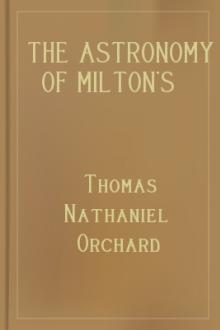The Astronomy of Milton's 'Paradise Lost' by Thomas Nathaniel Orchard (easy books to read in english TXT) 📕

- Author: Thomas Nathaniel Orchard
- Performer: -
Book online «The Astronomy of Milton's 'Paradise Lost' by Thomas Nathaniel Orchard (easy books to read in english TXT) 📕». Author Thomas Nathaniel Orchard
Milton does not fail to introduce into his poem several allusions to comets, and in doing so expresses the ideas and sentiments which in his time were associated with those objects.
In describing the hostile meeting between Satan and Death before the Gates of Hell, he writes:
Incensed with indignation, Satan stood
Unterrified, and like a comet burned,
That fires the length of Ophiuchus huge
In the arctic sky, and from his horrid hair
Shakes pestilence and war.—ii. 706-11.
This passage is eminently descriptive of the appearance of a great comet, and the occasion on which it is introduced adds to the intensity of the lurid imaginings and feelings of terror and dismay with which these objects have always been regarded. The comparison of the enraged Prince of Hell with one of those mysterious and fiery looking visitors to our skies was a grand conception of the poet’s, and one worthy of the mighty combatant. Ophiuchus (the Serpent-bearer) is a large constellation which occupies a rather barren region of the heavens to the south of Hercules. It has a length of about forty degrees, and is represented by the figure of a man bearing a serpent in both hands. It is not easy to imagine why Milton should have assigned the comet to this uninteresting constellation; he may possibly have seen one in this part of the sky, or his poetical ear may have perceived that the expression ‘Ophiuchus huge,’ which has about it a ponderous rhythm, was well adapted for the poetic description of a comet.
The only other allusion in the poem to a comet is near its conclusion, when the Cherubim descend to take possession of the Garden, prior to the removal of Adam and Eve—
The brandished sword of God before them blazed,
Fierce as a comet; which with torrid heat,
And vapour as the Lybian air adust
Began to parch that temperate clime.—xii. 632-36.
FALLING STARS
On any clear night an observer can, by attentively watching the heavens, perceive a few of those objects which become visible for a moment as a streak of light and then vanish. They are the result of the combustion of small meteoric masses having a celestial origin, and travelling with cosmical velocity, and which, in their headlong flight, become so heated by contact with the Earth’s atmosphere that they are converted into glowing vapour. This vapour when it cools condenses into fine powder or dust, and gradually descends upon the Earth’s surface, where it can be detected.
Shooting stars become visible at a height varying between twenty and one hundred and thirty miles, and their average velocity has been estimated at about thirty miles a second. Though casual falling stars can be seen at all times in every part of the heavens, yet there are certain periods at which they appear in large numbers, and have been observed to radiate from certain well-defined parts of the sky. When the radiant point is overhead, the falling stars spread out and resemble a parachute of fire; but when it is below the horizon, the stars ascend upwards like rockets into the sky. The radiant point is fixed among the stars, so that at the commencement of a shower it may be overhead, and before the termination of the display it may have travelled below the horizon. The radiant is usually named after the constellation in which it is observed.
The November meteors are called Leonids, because they radiate from a point in the constellation Leo; those in Taurus are called Taurids; in Perseus, Perseids; in Lyra, Lyraïds; and in Andromeda, Andromedes, because their radiant points are situated in those constellations.
The falling stars that have attracted most attention are those which appear on or about November 13. Every year at this period they can be seen in greater or less numbers, and on referring to numerous past records it has been ascertained that a magnificent display of those objects occurs every thirty-three years. The earliest historical allusion to this meteoric shower is by Theophanes, who wrote that in the year 472 A.D. the sky at Constantinople appeared to be on fire with falling stars. In the year 902 A.D. another remarkable display took place, and from that time until 1833 twelve conspicuous displays are recorded as having occurred at recurring intervals of thirty-three years. The grandest display of this kind that was ever witnessed occurred in 1833. It was visible over nearly the whole of the American continent, and, having commenced at midnight, lasted for four or five hours. The falling stars were so numerous that they appeared to rain upon the Earth, and caused the utmost consternation and terror among those who witnessed the phenomenon, many persons having imagined that the end of the world was at hand. The regular recurrence of these meteoric displays has been satisfactorily explained by the assumption that round the Sun there travels in an elliptical orbit with planetary velocity a vast shoal of meteoric bodies some millions of miles in length and several hundred thousand miles in breadth. The nearest point of their orbit to the Sun coincides with the Earth’s orbit, and the most distant part extends beyond the orbit of Uranus. These bodies accomplish a circuit of their orbit in 33¼ years. The Earth in her annual revolution intersects the path of the meteors, and when this occurs some falling stars can always be seen; but when the intersection happens at the time the shoal is passing, then there results a grand meteoric display. Numerous other meteoric swarms travel in orbital paths round the Sun.
Milton, in his poem, alludes to falling stars upon two occasions. In describing the fall of Mulciber from Heaven he says:—
To noon he fell, from noon to dewy eve,
A summer’s day; and with the setting sun
Dropt from the zenith like a falling star,
On Lemnos the Ægaean isle.—i. 742-46.
The rapid flight of the archangel Uriel from the Sun to the Earth is described in the following lines:—
On a sunbeam, swift as a shooting star
In autumn thwarts the night, when vapours fired
Impress the air, and shows the mariner
From what point of his compass to beware
Impetuous winds.—iv. 555-60.
Milton mentions the season of the year in which those stars are most frequently seen, and refers to an ancient belief by which they were regarded as the precursors of stormy weather. A translation from Virgil contains a similar allusion to them—
Star after star glide headlong down the skies.
The standard borne by the Cherub Azazel is described as having—
CHAPTER IX MILTON’S IMAGINATIVE AND DESCRIPTIVE ASTRONOMY
The theme chosen by Milton for his great epic, viz. the Fall of Man and his expulsion from Paradise—perhaps the most momentous incident in the history of the human race—was one worthy of the genius of a great poet and in the treatment of which Milton has been sublimely successful. The newly created Earth; the untainted loveliness of the Paradise in which our first parents dwelt during their innocence; their temptation; their fall and removal from the happy garden, furnished a theme which afforded him an opportunity for the display of his unrivalled poetic genius.
Though the chief interest in the poem is centred in the Garden of Eden and its occupants, yet Milton was enabled, by the comprehensive manner in which he treated his subject, to introduce into his work a cosmology which embraced not only the system to which our globe belongs, but the entire starry heavens by which we are surrounded. But the universality of his genius did not rest here. In the utterance of his sacred song he soared beyond the starry sphere, describing himself as wrapt above the pole—the starry pole—up to the Empyrean, or Heaven of Heavens, the ineffable abode of the Deity and the blissful habitation of angelic beings who, in adoration and worship, surround the throne of the Most High.
Descending to that nether world at the opposite pole of the universe, in the lowest depth of Chaos, the place prepared by Eternal Justice for the rebellious, he unfolds to our horror-stricken gaze the terrors of this infernal region; its fiery deluge of ever-burning sulphur; its ‘regions of sorrow;’ its ‘doleful shades’—the unhappy abode of fallen angels who ‘in floods and whirlwinds of tempestuous fire,’ alternated by exposure to unendurable cold and icy torment, experience the direful consequences of their apostacy.
Milton’s ‘Paradise Lost’ may be regarded as the loftiest intellectual effort in the whole range of literature. In it we find all that was known of science, philosophy, and theology. The theme, founded upon a Bible narrative, itself written under divine inspiration, embraces the entire system of Christian doctrine as revealed in the Scriptures, and many of the noblest passages in the sacred volume are introduced into the poem expressed in the lofty utterance of flowing and harmonious verse. The choicest classical writings of Greek and Latin authors; the mythological and traditional beliefs of ancient nations; historical incidents of valour and renown and all that was great and good in the annals of mankind were laid under contribution by Milton in the illustration and embellishment of his poem.
In order to obtain a basis or foundation upon which to construct his great epic, Milton found it necessary to localise the regions of space in which the principal events mentioned in his poem are described as having occurred. The unfathomable abyss of space may be regarded as an uncircumscribed sphere boundless on all sides round, and so far as we can comprehend of infinite extent. This sphere Milton divided into two hemispheres—an upper and a lower. The upper was called Heaven, or the Empyrean—a glorified region of boundless dimensions; the lower hemisphere embraced Chaos—a dark, fathomless abyss in which the elements of matter existed in a state of perpetual tumult and wild uproar. The occurrence of a rebellion in Heaven necessitated a further division of the sphere. The revolt, headed by Lucifer, one of the highest archangels, afterwards known as Satan, who drew after him a third of the angelic host, contested the supremacy of Heaven with Michael and the angels which kept their loyalty. After two days’ battle—
Hurled headlong flaming from the ethereal sky,
With hideous ruin and combustion, down
To bottomless perdition; there to dwell
In adamantine chains and penal fire.—i. 44-48.
Having been precipitated over the crystal wall of Heaven into the deep abyss, Milton says:—
And felt tenfold confusion in their fall
Through his wild Anarchy; so huge a rout
Encumbered him with ruin. Hell at last,
Yawning, received them whole, and on them closed.—vi. 871-75.
Hell, Milton locates in the lowest depth of Chaos, a region cut off from the body of Chaos, through which the expelled angels fell for nine days before reaching their destined habitation. There are now three divisions of space:





Comments (0)